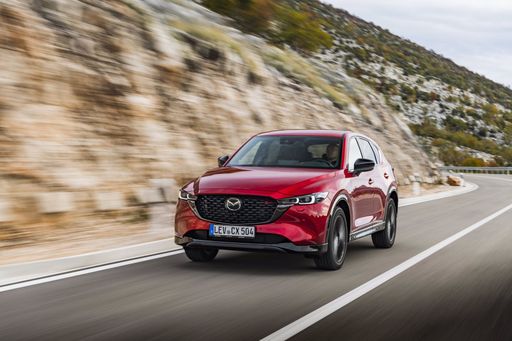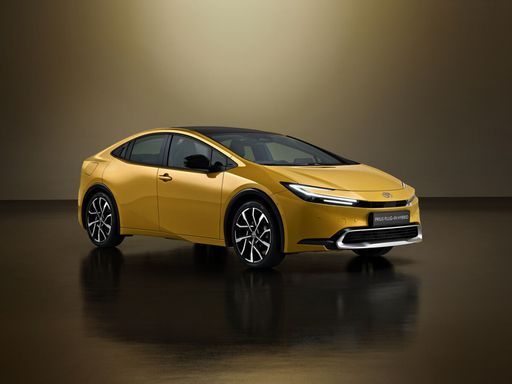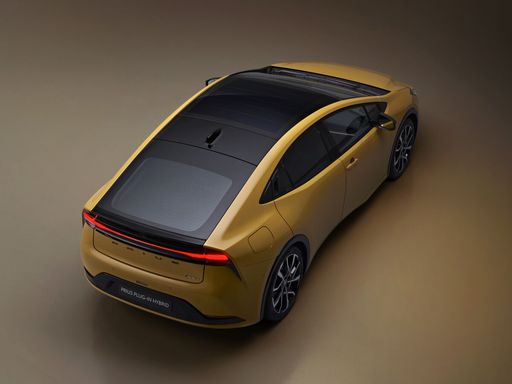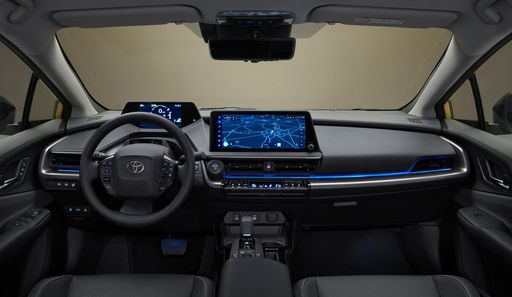Mazda CX-5 vs Toyota Prius – Differences & prices compared
Compare performance, boot space, consumption and price in one view.
Find out now: which car is the better choice for you – Mazda CX-5 or Toyota Prius?
The Mazda CX-5 (SUV) comes with a Petrol MHEV engine and Automatic transmission. In comparison, the Toyota Prius (Hatchback) features a Plugin Hybrid engine with Automatic transmission.
When it comes to boot capacity, the Mazda CX-5 offers 583 L, while the Toyota Prius provides 284 L – depending on how much space you need. If you’re looking for more power, decide whether the 141 HP of the Mazda CX-5 or the 223 HP of the Toyota Prius suits your needs better.
In terms of consumption, the values are 7 L per 100 km for the Mazda CX-5, and 0.50 L for the Toyota Prius.
Price-wise, the Mazda CX-5 starts at 30000 £, while the Toyota Prius is available from 39400 £. Compare all the details and find out which model fits your lifestyle best!
In the latest matchup between the Mazda CX-5 and the Toyota Prius, the compact SUV showcases its sporty profile and engaging driving dynamics, making it a strong contender for those seeking versatility and style. Meanwhile, the Prius remains a champion of fuel efficiency, appealing to eco-conscious buyers with its hybrid technology and spacious interior. Ultimately, the choice between the two hinges on whether buyers prioritize performance or fuel economy in their daily drives.
Mazda CX-5
The Mazda CX-5 exemplifies the perfect blend of style and practicality, offering a sleek design that turns heads while providing ample space for passengers and luggage. Its refined interior boasts high-quality materials and a user-friendly interface, making every journey a comfortable experience. With its engaging driving dynamics, the CX-5 delivers both performance and efficiency, appealing to drivers who crave excitement and reliability.
details @ de.mazda-press.com
@ de.mazda-press.com
 @ de.mazda-press.com
@ de.mazda-press.com
 @ de.mazda-press.com
@ de.mazda-press.com
Toyota Prius
The Toyota Prius stands as a pioneer in the realm of hybrid vehicles, offering an eco-friendly driving alternative with its innovative technology. Its aerodynamic design and comfortable interior make it a practical choice for those looking to reduce their carbon footprint without sacrificing style. Additionally, the Prius boasts a reputation for reliability and efficiency, contributing to its lasting popularity among environmentally conscious drivers.
details @ Toyota
@ Toyota
 @ Toyota
@ Toyota
 @ Toyota
@ Toyota
 @ Toyota
@ Toyota
The automotive market is constantly evolving, presenting consumers with a myriad of options. Among the significant entries are the Mazda CX-5 and the Toyota Prius, two vehicles that encompass different automotive philosophies. While the CX-5 represents a robust and versatile SUV, the Prius embodies cutting-edge hybrid technology and fuel efficiency. Let’s delve into the details of these two models, considering their technical aspects and innovations.
Design and Body Type
The Mazda CX-5 features an elegant SUV design that offers higher seating and enhanced visibility, making it a preferred choice for families and adventure seekers. Measuring 4575 mm in length, 1845 mm in width, and 1680 mm in height, it provides a spacious interior and ample trunk capacity of 522 liters.
On the other hand, the Toyota Prius is a sleek hatchback designed for efficiency. With a length of 4599 mm, a width of 1782 mm, and a height of 1470 mm, it has a more compact footprint suited for urban driving. However, its trunk capacity of just 284 liters might be a downside for those needing more cargo space.
Powertrain and Performance
The Mazda CX-5 offers a range of engines, including petrol MHEV and diesel options, with power outputs ranging from 165 to 194 HP. Its acceleration from 0 to 100 km/h ranges from 9.2 to 11.1 seconds, depending on the engine configuration. Fuel consumption stands at around 5.6 to 7.6 L/100 km, which is reasonable for an SUV.
In contrast, the 2023 Toyota Prius is powered solely by a plug-in hybrid engine with an output of 223 HP, delivering an impressive acceleration of 6.8 seconds from 0 to 100 km/h. The Prius is optimized for efficiency, with a low fuel consumption of just 0.5 to 0.7 L/100 km and an electric range of up to 86 km, making it an excellent choice for daily commuters looking to minimize fuel costs.
Transmission and Driving Experience
The CX-5 offers both manual and automatic transmission options, enhancing the driving experience for those who prefer a hands-on approach or the ease of automatic driving. It features front-wheel drive and all-wheel drive options for varied driving conditions.
Conversely, the Prius utilizes a continuously variable transmission (CVT) that provides a smooth and efficient drive, particularly suited for city commuting. Its front-wheel drive configuration further aligns with its efficiency-boosting design.
Innovations and Technological Features
The Mazda CX-5 boasts several technological innovations, including a touchscreen infotainment system, advanced safety features such as adaptive cruise control, lane departure warning, and a host of driving aids that enhance the overall driving experience.
The Toyota Prius, known for its eco-friendly approach, integrates an array of cutting-edge technology. Its advanced hybrid system offers unparalleled energy efficiency, while features like adaptive headlights and a comprehensive suite of safety technology underscore its commitment to innovation. The car’s user interface is intuitive, making it easy for drivers to access vital information regarding their driving efficiency and battery status.
Environmental Impact and Efficiency
In terms of CO2 emissions, the Mazda CX-5 falls within efficiency classes E to F, emitting between 146 to 173 g/km. With its diesel engines offering reasonable fuel economy, it's a practical choice among SUVs.
The Toyota Prius, however, stands out with an impressive CO2 efficiency class B, emitting just 12 to 17 g/km. With its focus on hybrid technology, it represents a significant advancement in eco-friendly driving, appealing to those environmentally conscious buyers.
Conclusion
Choosing between the Mazda CX-5 and the Toyota Prius ultimately depends on what you value most in a vehicle. The CX-5 offers the versatility and space of an SUV, making it perfect for families and adventurous spirits. The Prius, with its cutting-edge hybrid technology and exceptional fuel efficiency, is ideal for those seeking a green alternative for everyday commuting.
Each car brings its unique advantages to the table, catering to different needs and preferences in the burgeoning automotive landscape.

|

|
|
|
|
Costs and Consumption |
|
|---|---|
|
Price
30000 £
|
Price
39400 - 45800 £
|
|
Consumption L/100km
7 L
|
Consumption L/100km
0.5 - 0.7 L
|
|
Consumption kWh/100km
-
|
Consumption kWh/100km
-
|
|
Electric Range
-
|
Electric Range
72 - 86 km
|
|
Battery Capacity
-
|
Battery Capacity
-
|
|
co2
157 g/km
|
co2
12 - 17 g/km
|
|
Fuel tank capacity
56 L
|
Fuel tank capacity
40 L
|
Dimensions and Body |
|
|---|---|
|
Body Type
SUV
|
Body Type
Hatchback
|
|
Seats
5
|
Seats
5
|
|
Doors
5
|
Doors
5
|
|
Curb weight
1629 kg
|
Curb weight
1620 - 1630 kg
|
|
Trunk capacity
583 L
|
Trunk capacity
284 L
|
|
Length
4690 mm
|
Length
4599 mm
|
|
Width
1860 mm
|
Width
1782 mm
|
|
Height
1695 mm
|
Height
1470 mm
|
|
Payload
-
|
Payload
365 - 375 kg
|
Engine and Performance |
|
|---|---|
|
Engine Type
Petrol MHEV
|
Engine Type
Plugin Hybrid
|
|
Transmission
Automatic
|
Transmission
Automatic
|
|
Transmission Detail
Automatic Gearbox
|
Transmission Detail
-
|
|
Drive Type
Front-Wheel Drive
|
Drive Type
Front-Wheel Drive
|
|
Power HP
141 HP
|
Power HP
223 HP
|
|
Acceleration 0-100km/h
10.50 s
|
Acceleration 0-100km/h
6.80 s
|
|
Max Speed
195 km/h
|
Max Speed
177 km/h
|
|
Torque
238 Nm
|
Torque
-
|
|
Number of Cylinders
4
|
Number of Cylinders
4
|
|
Power kW
104 kW
|
Power kW
164 kW
|
|
Engine capacity
2488 cm3
|
Engine capacity
1998 cm3
|
General |
|
|---|---|
|
Model Year
2025
|
Model Year
2023
|
|
CO2 Efficiency Class
F
|
CO2 Efficiency Class
B
|
|
Brand
Mazda
|
Brand
Toyota
|
Mazda CX-5
Experience the Mazda CX-5: A Blend of Style and Performance
The Mazda CX-5 is an outstanding example of how contemporary SUVs are redefining the driving experience by combining stylish design, advanced technology, and impressive performance. This compact SUV has continually evolved since its introduction, becoming a favourite among driving enthusiasts and everyday users alike. In this article, we'll delve into the technical details and innovative features that set the Mazda CX-5 apart from its competitors.
Powertrains and Performance: A Broad Spectrum of Choices
The Mazda CX-5 offers a plethora of engine choices tailored to meet diverse driving demands. The powertrains include both petrol mild-hybrid and diesel options, ensuring an optimal blend of efficiency and power. Engine capacities range from 150 to 194 PS, providing drivers with the flexibility to choose their desired level of performance. Whether cruising on highways or tackling rugged terrains, the CX-5 offers a balanced drive thanks to its fine-tuned suspension and steering dynamics.
Innovative e-SKYACTIV Technology
One of the standout features of the Mazda CX-5 is its proprietary e-SKYACTIV technology. This innovation is not only about enhancing fuel efficiency but also ensuring a cleaner emission profile. By integrating mild-hybrid systems with traditional combustion engines, Mazda optimises energy use during different phases of driving, such as acceleration and coasting, thereby enhancing overall efficiency without compromising on performance.
Driving Comfort and Cabin Features
Inside the Mazda CX-5, an array of advanced features fosters a premium driving experience. Depending on the trim level—ranging from 'Prime-Line' to the luxurious 'Takumi AWD SKYACTIV-Drive'—owners enjoy a wealth of connectivity and convenience functions. From adaptive cruise control to an immersive infotainment system, each trip promises to be as enjoyable as it is efficient. Additionally, the CX-5 boasts a generous boot space of up to 522 litres, ensuring ample room for long journeys or family outings.
Safety First: Advanced Safety Technologies
Safety is a paramount consideration in the engineering of the Mazda CX-5. Equipped with an array of advanced safety technologies, the vehicle is designed to protect its occupants and enhance overall safety on the road. Features such as lane-keep assist, blind-spot monitoring, and a comprehensive set of airbags ensure that the CX-5 is well-prepared for unforeseen challenges while driving.
Efficiency Meets Affordability
The various models of the Mazda CX-5 provide a spectrum of fuel consumption figures spanning from 5.6 to 7.6 L/100km, catering to drivers who are both economy-conscious and seek strong performance. With its CO2 efficiency classes rating between E and F, the CX-5 balances performance and responsibility. Offered at a price range from €32,190 to €51,700, the CX-5 positions itself as an attainable luxury within the SUV market.
Conclusion: The Mazda CX-5 Legacy
The Mazda CX-5’s blend of technological innovations, robust engines, and sleek design underscores its status as a top choice in the compact SUV segment. Its commitment to improving performance while maintaining fuel efficiency and safety makes it a compelling option for discerning drivers. As Mazda continues to push boundaries with cutting-edge technology and design, the CX-5 remains a testament to the brand’s dedication to creating vehicles that inspire and deliver an exceptional driving experience.
Toyota Prius
The All-New Toyota Prius: Revolutionising Efficiency and Performance
The Toyota Prius, a name synonymous with hybrid innovation, has once again shown why it remains at the forefront of eco-friendly automotive technology. The latest models have enhanced technical features and innovations, setting new standards for efficiency and driving experience.
Hybrid Performance: A Leap Forward
The latest Prius models employ a sophisticated 2.0 litre Plug-in Hybrid system that flawlessly melds petrol and electric power. With a power output of 223 PS, it propels the Prius with impressive dynamism, reaching 0-100 km/h in just 6.8 seconds. This performance-oriented aspect of the Prius does not compromise on efficiency, with an astonishing fuel consumption ranging from 0.5 to 0.7 L/100km.
Electric Range and Efficiency
One of the key highlights of the new Prius is its substantial electric-only range. Depending on the variant, it can travel between 72 to 86 km on electric power alone, making it an ideal choice for urban commutes where zero emissions are preferred. The hybrid system's CO2 emissions are remarkably low, between 12 and 17 g/km, contributing to its CO2 Efficiency Class B rating.
Engineering Excellence with CVT
The Prius is equipped with a state-of-the-art Continuously Variable Transmission (CVT), ensuring a smooth and efficient drive. This advanced transmission supports the front-wheel-drive layout, delivering power seamlessly and enhancing driving pleasure without sacrificing fuel economy.
Stylish Design and Comfort
Designed as a sleek five-door hatchback, the Prius offers a comfortable and spacious interior with seating for five passengers. It measures 4599 mm in length, 1782 mm in width, and 1470 mm in height, offering a practical balance of size and comfort. The boot space, while tailored for the hybrid battery, still provides a decent 284 litres of storage.
Cost Efficiency
The running costs of the Prius are competitive, with monthly expenses estimated between €1064 and €1188, and cost per kilometre ranging from 42.6 to 47.5 cents. Its efficient design results in a maximum speed of 177 km/h and a practical fuel tank size of 40 litres, ensuring less frequent stops on longer journeys.
Conclusion: The Prius Legacy Continues
The Toyota Prius continues to lead by example in the realm of hybrid technology. Combining impressive power with unmatched efficiency and a sophisticated driving experience, it is clear that the Prius remains a compelling choice for the environmentally conscious driver. Its innovative features and favourable cost metrics only bolster its appeal in the modern automotive landscape.
Is the Mazda CX-5 offered with different drivetrains?
Available configurations include Front-Wheel Drive.
The prices and data displayed are estimates based on German list prices and may vary by country. This information is not legally binding.
